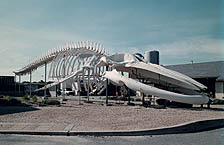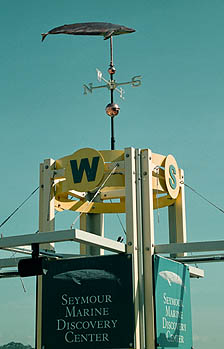
February 19, 2001
Long Marine Laboratory to celebrate return of newly refurbished blue whale skeleton
By Tim Stephens
It's back and better than ever. The 87-foot blue whale skeleton at Long Marine Laboratory
has been painstakingly refurbished and reassembled next to the lab's Seymour Marine
Discovery Center. To celebrate the return of this beloved icon, the lab will hold
a "re-dedication" ceremony on Sunday, February 25, from 1 to 1:30 p.m.
A new blue whale weather vane atop the sign at the entrance to the Seymour Center
will also be unveiled.
 |
| The skeleton of a blue whale at Long Marine Laboratory has been refurbished, and missing bones have been replaced. A new blue whale weather vane (below) atop the entrace to the Seymour Center will be unveiled at a "rededication" ceremony on February 25. Photo: Tim Stephens |
 |
The blue whale skeleton was first assembled in 1986 and has been a centerpiece of the lab's public education programs ever since. When the time came to move the skeleton to its new site beside the Seymour Center, lab staff decided to take the opportunity to refurbish it and replace some missing bones. Campus veterinarian Dave Casper was put in charge of the task.
"We had always wanted to complete the skeleton, and this seemed like a good time to do it," Casper said. "It ended up taking quite a while, and people were nervous while it was gone. The whale has always been special to people at the lab. Everybody feels affection for this whale--researchers, students, volunteers, and visitors--so it's a joyful homecoming for it to be up again."
The newly refurbished skeleton is a sight to behold, even more imposing than it was before. Mounted on a new steel framework, it now rises 15 feet in the air at the highest point. The tail, now complete all the way down to a thumb-size bone at the end, extends over the sidewalk at a height of about 8 feet. In addition, the flippers are now flexed away from the ribs in a typical swimming position, giving the skeleton a more lifelike pose. Julie Barrett Heffington, director of the Seymour Center, has a view of the skeleton from her office window.
"I see people gazing at it all the time, from little kids to adults, and it's wonderful to see how the sheer size of it impresses people," Heffington said. "People are just drawn to it."
The skeleton came from a female blue whale that died of unknown causes and washed ashore on Pescadero Beach in 1979. After several days of jurisdictional uncertainty, UCSC biologists and students began working to salvage the skeleton. Removing the blubber and flesh from the bones, a process called "flensing," took nearly a month. Lisa Borok, now visitor programs manager at the Seymour Center, was one of the many students and staffers who volunteered to help.
"I'll never forget that smell--it was horrible--but the work was fun," Borok said. "It was kind of weird and gross and fun at the same time. The amazing thing was how heavy the bones were due to all the oil in them--three of us couldn't lift a vertebra that was only about a foot in diameter."
Transported by helicopter and truck to the marine lab, the whale's skeleton then lay in a grassy field just downwind of the lab buildings for over a year before being buried. Burying the bones allowed nature's decomposers to clean away the remaining tissue and oil. In the summer of 1985, the bones were unearthed and reconstruction began. Frank Perry, a local geologist and museum specialist, was hired to clean the bones and mount them for display. Working with lab staff and specialists from the Santa Barbara Museum of Natural History and the California Academy of Sciences, they constructed a steel framework to support the bones and re-create the proper arch of the spine. The job was completed in late 1986.
Most of the whale's skeleton was recovered intact, but some of the bones were damaged or lost as the decomposing carcass rolled around in the surf. To complete the skeleton, Casper had to re-create about 60 lost bones, mostly small ones in the tail and flippers plus a few large vertebrae. He painstakingly created molds of the missing parts from bones loaned by other institutions or from similar bones in the existing skeleton. Teaching himself the techniques from books and getting advice from taxidermists, Casper cast each piece out of polyurethane foam, with an outer layer of fiberglass. Each new bone was primed and painted, and the rest of the skeleton also got a new coat of paint.
Funding for the refurbishing project was provided by George and Linda Malloch and Cargill Salt. The new weather vane, an original production, was donated by LizAnne and Ken Jensen, artists and owners of West Coast Weather Vanes.
Return to Front Page